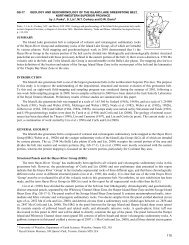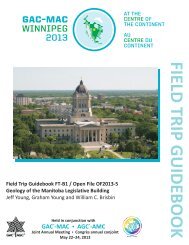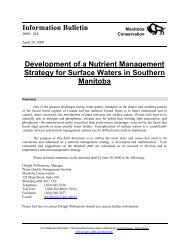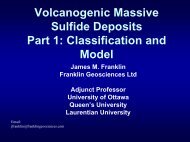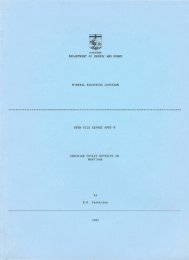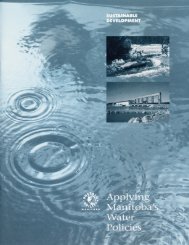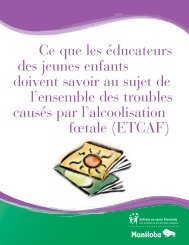Physical Volcanology, Hydrothermal Alteration and Massive ...
Physical Volcanology, Hydrothermal Alteration and Massive ...
Physical Volcanology, Hydrothermal Alteration and Massive ...
You also want an ePaper? Increase the reach of your titles
YUMPU automatically turns print PDFs into web optimized ePapers that Google loves.
massive chloritic veining up to 50 cm wide occurs.This chloritic veining is probably the result of fresh seawater recharge into a hothydrothermal system causing abrupt increases in magnesium content <strong>and</strong> thus formingchlorite alteration. The quartz-filled tension fractures evident in this outcrop are probablydue to volume changes during hydrothermal alteration. Kyanite can be found in thesefracture-fillings on the south section of the outcrop. A 10-20 cm wide b<strong>and</strong> of silicifiedrock, striking N-S, bisects the outcrop. Samples from this b<strong>and</strong> contain 50% quartz, 15%chloritoid, 15% sericite or pyrophyllite (probably replacing <strong>and</strong>alusite), 8% Fe-richcarbonate, 7% chlorite, 2% relict <strong>and</strong>alusite, <strong>and</strong> 2% opaque minerals. This b<strong>and</strong> of moreintense alteration probably represents a conduit for upward high- temperature fluidmovement, which was later overprinted by sericite (+K) <strong>and</strong> chlorite (+Mg) alteration.Stop M-1d: Mesobreccia (HLMBX) And Synvolcanic Fault ZoneTI1is series of outcrops shows a definable, confined <strong>and</strong> symmetrically zonedincrease in alteration intensity through a synvolcanic fault structure within the HLMBX unit.The texture of the HLMBX unit near the synvolcanic fault is strongly overprinted but is stillrecognizable due to the abundance of relatively unaltered felsic lithic fragments. <strong>Alteration</strong>in the small outcrop on the road <strong>and</strong> immediately north of the road consists of 1-4 cm clotsof Fe-carbonate-rich material surrounded by anastomosing veinlets of quartz, chloritoid± <strong>and</strong>alusite. The dominant change in rock mineralogy from the previous outcrop (M-1 c)is an increase in the amount of Fe-rich carbonate <strong>and</strong> chloritoid.Stop M-2: Mattabi Ash Flow Tuffs (MTQ)This outcrop consists of Mattabi Succession quartz crystal ash flow tuff. Thisexposure contains 10-50% 5-30 mm rounded cherty juvenile felsic fragments, 5-15% 5-30mm rounded pumice, filled by quartz ± sulphide, <strong>and</strong> 2-7% 0.5-1.5 mm colourless quartzcrystals. The recrystallized altered ash matrix consists of fine quartz (40-50%), chloritoid(10-30%), sericite ± pyrophyllite (15-35%, after <strong>and</strong>alusite?), <strong>and</strong>alusite (0-5%) <strong>and</strong>opaque minerals (1-5%).Lithic fragments consist of quartz ± sericite ± pyrophyllite <strong>and</strong>the pumice are filled <strong>and</strong>/or replaced by quartz ± sulphide.30



